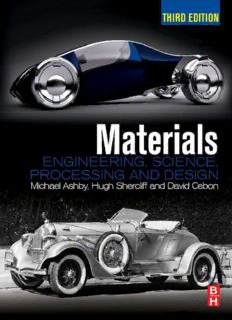Table Of ContentMaterials
Engineering, Science, Processing and
Design
THIRD EDITION
Michael Ashby
Department of Engineering, University of Cambridge, UK
Hugh Shercliff
Department of Engineering, University of Cambridge, UK
David Cebon
Department of Engineering, University of Cambridge, UK
Table of Contents
Cover image
Title page
Copyright
Preface to 3rd edition
Science-led or design-led? Two approaches to materials teaching
What is different about this book?
What’s new in the 3rd edition
This book and the CES EduPack Materials and Process Information software
Acknowledgements
Reviewers
Advisors
Resources that accompany this book
Resources available to adopting instructors who register on the Elsevier textbook website,
http://textbooks.elsevier.com:
Chapter 1. Introduction: materials-history and character
Abstract
1.1 Materials, processes and choice
1.2 Material properties
1.3 Design-limiting properties
1.4 Summary and conclusions
1.5 Further reading
1.6 Exercises
Chapter 2. Family trees: organising materials and processes
Abstract
2.1 Introduction and synopsis
2.2 Getting materials organised: the materials tree
2.3 Organising processes: the process tree
2.4 Process-property interaction
2.5 Material property charts
2.6 Computer-aided information management for materials and processes
2.7 Summary and conclusions
2.8 Further reading
2.9 Exercises
2.10 Exploring design using CES
2.11 Exploring the science with CES Elements
Chapter 3. Strategic thinking: matching material to design
Abstract
3.1 Introduction and synopsis
3.2 The design process
3.3 Material and process information for design
3.4 The strategy: translation, screening, ranking and documentation
3.5 Examples of translation
3.6 Summary and conclusions
3.7 Further reading
3.8 Exercises
3.9 Exploring design using CES
Chapter 4. Stiffness and weight: density and elastic moduli
Abstract
4.1 Introduction and synopsis
4.2 Density, stress, strain and moduli
4.3 The big picture: material property charts
4.4 The science: what determines stiffness and density?
4.5 Manipulating the modulus and density
4.6 Acoustic properties
4.7 Summary and conclusions
4.8 Further reading
4.9 Exercises
4.10 Exploring design with CES
4.11 Exploring the science with CES Elements
Chapter 5. Flex, sag and wobble: stiffness-limited design
Abstract
5.1 Introduction and synopsis
5.2 Standard solutions to elastic problems
5.3 Material indices for elastic design
5.4 Plotting limits and indices on charts
5.5 Case studies
5.6 Summary and conclusions
5.7 Further reading
5.8 Exercises
5.9 Exploring design with CES
5.10 Exploring the science with CES Elements
Chapter 6. Beyond elasticity: plasticity, yielding and ductility
Abstract
6.1 Introduction and synopsis
6.2 Strength, plastic work and ductility: definition and measurement
6.3 The big picture: charts for yield strength
6.4 Drilling down: the origins of strength and ductility
6.5 Manipulating strength
6.6 Summary and conclusions
6.7 Further reading
6.8 Exercises
6.9 Exploring design with CES
6.10 Exploring the science with CES Elements
Chapter 7. Bend and crush: strength-limited design
Abstract
7.1 Introduction and synopsis
7.2 Standard solutions to plastic problems
7.3 Material indices for yield-limited design
7.4 Case studies
7.5 Summary and conclusions
7.6 Further reading
7.7 Exercises
7.8 Exploring design with CES
Chapter 8. Fracture and fracture toughness
Abstract
8.1 Introduction and synopsis
8.2 Strength and toughness
8.3 The mechanics of fracture
8.4 Material property charts for toughness
8.5 Drilling down: the origins of toughness
8.6 Compressive and tensile failure of ceramics
8.7 Manipulating properties: the strength–toughness trade-off
8.8 Summary and conclusions
8.9 Further reading
8.10 Exercises
8.11 Exploring design with CES
8.12 Exploring the science with CES Elements
Chapter 9. Shake, rattle and roll: cyclic loading, damage and failure
Abstract
9.1 Introduction and synopsis
9.2 Vibration and resonance: the damping coefficient
9.3 Fatigue
9.4 Charts for endurance limit
9.5 Drilling down: the origins of damping and fatigue
9.6 Manipulating resistance to fatigue
9.7 Summary and conclusions
9.8 Further reading
9.9 Exercises
9.10 Exploring design with CES
Chapter 10. Keeping it all together: fracture-limited design
Abstract
10.1 Introduction and synopsis
10.2 Standard solutions to fracture problems
10.3 Material indices for fracture-safe design
10.4 Case studies
10.5 Summary and conclusions
10.6 Further reading
10.7 Exercises
10.8 Exploring design with CES
Chapter 11. Rub, slither and seize: friction and wear
Abstract
11.1 Introduction and synopsis
11.2 Tribological properties
11.3 Charting friction and wear
11.4 The physics of friction and wear
11.5 Friction in design and metal processing
11.6 Summary and conclusions
11.7 Further reading
11.8 Exercises
11.9 Exploring design with CES
Chapter 12. Agitated atoms: materials and heat
Abstract
12.1 Introduction and synopsis
12.2 Thermal properties: definition and measurement
12.3 The big picture: thermal property charts
12.4 Drilling down: the physics of thermal properties
12.5 Manipulating thermal properties
12.6 Design and manufacture: using thermal properties
12.7 Summary and conclusions
12.8 Further reading
12.9 Exercises
12.10 Exploring design with CES
12.11 Exploring the science with CES Elements
Chapter 13. Running hot: using materials at high temperatures
Abstract
13.1 Introduction and synopsis
13.2 The temperature dependence of material properties
13.3 Charts for creep behaviour
13.4 The science: diffusion
13.5 The science: creep
13.6 Materials to resist creep
13.7 Design to cope with creep
13.8 Summary and conclusions
13.9 Further reading
13.10 Exercises
13.11 Exploring design with CES
Description:READERSHIP: Undergraduate materials, mechanical, chemical, civil & aeronautical engineering students taking courses in materials science & engineering, materials processing and engineering design. "Materials: Engineering, Science, Processing and Design" — winner of a 2014 Textbook Excellence Award

